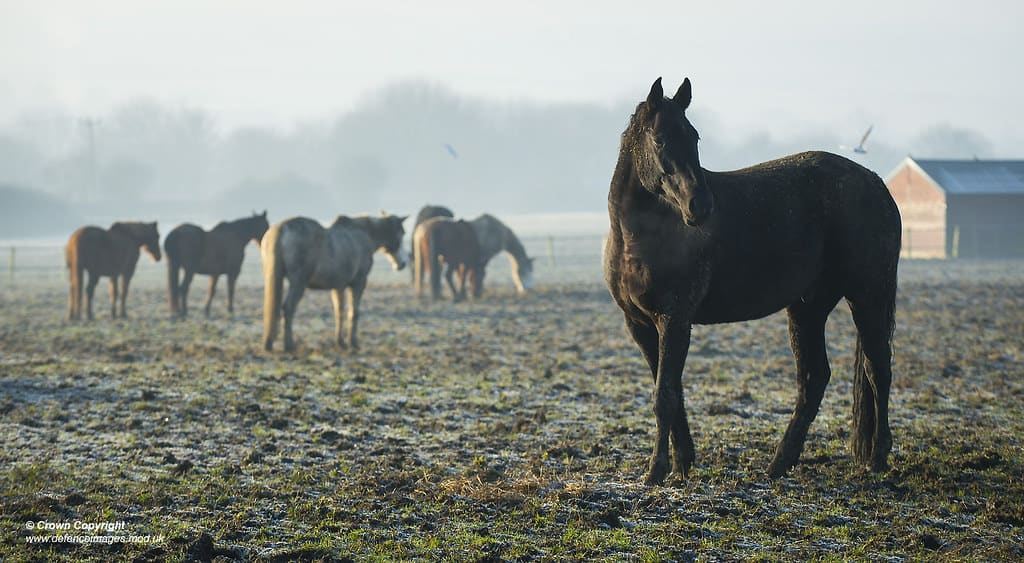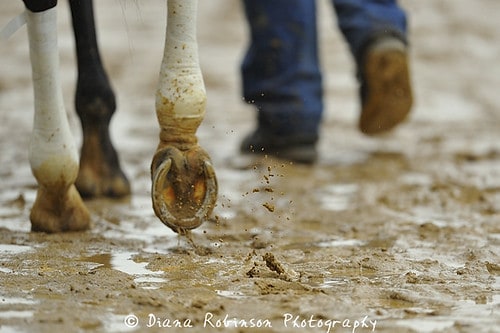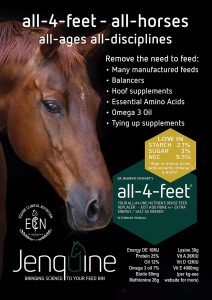
“Horses are returning to London” by Defence Images is licensed under CC BY-NC-SA 2.0
Horses are amazing the way they adapt to wherever we put them – yards, stables, paddocks, wet, dry, soft or hard ground. To keep the hooves strong, we need to be aware of and to prepare for changes in weather and season. Climate and weather vary depending on where in Australia you live, and the ‘normal’ moisture content of your horse’s hooves varies too. The hoof is a bit like a ‘sponge’, when it gets wet it increases in size and becomes softer and weaker. This means it is more fragile and if it stays wet it is more prone to cracks, breaks, infections and flares. Your vet and farrier will be able to see the visible changes and advise straight away.
Hooves can adapt well over time to conditions that are consistently dry or consistently damp. It’s when the environment fluctuates between wet and dry that hooves suffer the most. This is especially important for horses that are in a dry stable overnight then venture off into the dewy wet grass in the morning – going back and forth many times a day. With repetition of this cycle, horseshoe nails loosen as their holes through the hoof wall enlarge slightly. The constant switching from wet to dry and back again over days and weeks can eventually lead to loss of hoof strength and then to thin soles.
Poor hoof quality can be due to multiple factors: poor nutrition, lack of trimming and shoeing, excess moisture and genetics. One of the more common causes of hoof problems is too much moisture in the hoof. Horses that live in wet, humid environments, those that are bathed repeatedly, and horses that are kept on damp bedding or stand in the mud for long periods of time are at the greatest risk.

“Horse and walker on muddy Derby track” by diana_robinson is licensed under CC BY-NC-ND 2.0
Winter: Feet are healthier when they are not constantly wet and for horses living in a moist area, feet become too soft. Having an area in their paddock that’s higher and drier lets them get out of the mud and enables the foot to dry a little.
Hygiene and Hoof Dressings: Check your horses’ feet frequently to make sure they are not packed with rocks or mud, which can also exacerbate the wet-dry cycle. If you have to bathe a horse a lot or his feet are starting to dry out and crack from the wet/dry cycle, ask your farrier or vet to recommend a non-drying hoof dressing.
Understanding the environment the horse lives in and the different ground surfaces they encounter through the day guides us on when to apply hoof sealants or water repellents. Your vet or farrier can again advise on your individual horse. They can also guide you during extended weather conditions, when a more permanent solution – such as sole pads to reduce excess moisture in the soles – can help.
- Inspect your horse’s hoofs and pick out daily – ideally twice a day (find a good resource on how to do this here)
- Avoid your horse standing in wet and muddy conditions for long periods – make sure they have somewhere dry to stand for at least part of the day
- Put drainage where horses gather, such as gateways and water troughs.
- Fence off any particularly muddy areas
- Maintain good stable hygiene with clean dry bedding.
Feed the feet: Hoof health depends on a balanced diet and a steady stream of nutrients – however, overfeeding and overlap is not uncommon when several different supplements are used to try and address individual nutrients. Before you reach for a hoof-oriented supplement, talk to a veterinary nutritionist or farrier about its nutrient content.
As winter continues for a few more months, expect to see changes in the environment and hooves. With proper hoof care and keeping an eye on the wetness of the ground, we can help hooves can stay strong.
DISCLAIMER All content provided in this article is for general use and information only and does not constitute advice or a veterinary opinion. It is not intended as specific medical advice or opinion and should not be relied on in place of consultation with your veterinarian.
More information on equine nutrition is available at www.jenquine.com
Meet the author and PCA’s resident equine nutritionist
Dr Jennifer Helen Stewart
BVSc BSc PhD Dip BEP MRCVS
Equine Veterinarian and Consultant Nutritionist – CEO Jenquine

Dr Jennifer Stewart is an equine veterinarian with over thirty five years’ experience. She is also a consultant nutritionist and has formulated feeds, custom mixes and supplements for leading international horse feed manufacturers in Australia, India, Ireland, Japan, New Zealand, Philippines, South Africa, Thailand, Turkey and the UAE. Dr Stewart is passionate about equine nutrition and its role in the management, treatment and prevention of many equine diseases. She is committed to bringing ‘science to the feed bin’.
Dr Stewart graduated BSc (vet) and BVSc at the University of Sydney. Her research thesis was “Resistance of Equine Strongyles to Benzimidazole Anthelmintics” and her PhD “Studies on Heart and Lung Function in Foals”. She worked at the Universities of North Carolina, Michigan and Florida USA in equine medicine, antibiotics and exercise physiology. Following this was a time spent in Newmarket and Cambridge England, in stud and race track research and practice, before establishing an exclusively equine practice on the Central Coast of NSW Australia. She has been an official veterinarian for the Australian Jockey Club for over 20 years, was one of the team of equine veterinarians for the Sydney 2000 Olympic Games and consultant nutritionist for Mitavite for 10 years.
Dr Stewart has spent over twenty five years working on collaborative research projects into gastrointestinal and exercise physiology with major Universities; lecturing and supervising university and TAFE students; consulting to veterinary practices, trainers, pony clubs, owners, equestrian centres and studs; speaking at seminars in Australia, Middle East, South Africa, Philippines, SE Asia, Hong Kong, Japan, Turkey, India and New Zealand, and writing regularly for equine industry magazines. This experience in research, equine medicine and veterinary practice has given Dr Stewart a deep understanding of the complexities of equine health and performance; growth and development of young horses, and feeding practices for the management and prevention of diseases.
Watch Dr Stewart talk about her first love of horses and why she chose to become a vet in this short clip. Pony Club Australia is grateful for Dr Stewart preparing this laminitis article for our Horse Resource page. Please browse her other articles, blog and resources at Jenquine.


